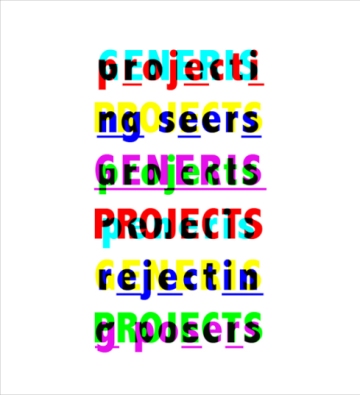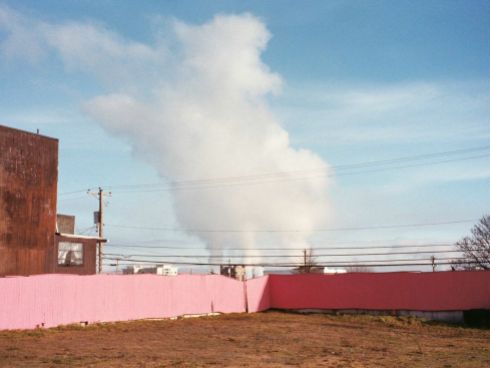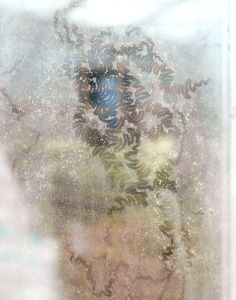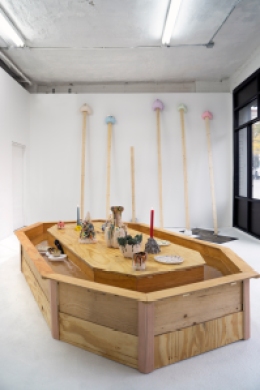
“Tacoma is to Seattle as Brooklyn is to Manhattan” is a notion locals have been floating for about a dozen years to communicate something about our art scene. Sure, Tacoma may lack the canned-sardine density of artists and exotic flavors that its counterpart has – but a talented creative base definitely exists here and is thriving in a focused, forceful, non-exclusive, collaborative way that cultural observers have taken note of.

What can Tacoma and Brooklyn learn from each other? What are the common, underlying conditions artists face? That is what curator Susan Surface sought to uncover in her bi-coastal project, Generis 01T: ZIP CODE. It’s a Spaceworks project in two parts: Surface selected local curator Katy Evans to name four Tacoma artists – Sarah Gilbert, Sarah E. Gilbert, Nicholas Nyland, and Sean Alexander – to participate in a group show, Generis 01B: COMMUNITY ASSOCIATION, in Brooklyn last fall. This season, Surface selected local photographer Evan Soto and musician/writer Hozoji Matheson-Margullis; and Brooklyn photographer Michael Vahrenwald to mount a companion show in Tacoma, Generis 01T: ZIP CODE. This exhibit is now on view in the Woolworth Windows.

In a curatorial statement, Surface positions “Tacoma, Washington and Brooklyn, New York as case studies for each other. In Tacoma, artists and art spaces have a long civic tradition of integration into all walks of life as neighbors, educators, and exhibitors. But in cities like New York, which foster both art-world competition and developer-led real estate squeeze, artists have gained a reputation as outsider-gentrifiers of naturally occurring cultural districts. Despite their geographic and circumstantial differences, the exhibition positions Tacoma as a model, at least in attitude and approach, of an artistic infrastructure for all.”
Surface, a graduate of Parsons School of Design, with a masters degree in architecture from Yale, lived in New York the past 3 years before moving back to the Northwest last month. The Spaceworks collaboration touches on how artists and creative communities vye for sustainability within and without their boundaries.
The Brooklyn program emphasized how the arts can serve new and long-term residents of a neighborhood while at the same time encouraging the flow of art between different geographical areas. For the Tacoma exhibit, “It’s a totally different sort of space. The Woolworth Windows can’t be entered by the public physically – they’re displays that are viewed from the outside in. But they also never close. They’re open 24/7 for three and a half months, through dark and light, [and] all kinds of weather.”
Given her experience of both cities, we wanted to find out more about the ZIP CODE project:
Spaceworks Tacoma: How does Artscapes (the exhibition arm of Spaceworks) fit into the picture of ZIP CODE?
Susan Surface: They provide the space, of course! They’ve been immensely supportive of the project, and do a ton of the crucial media and promotional outreach. It sounds like such a simple thing to say, but without the space, there’d be no exhibition. Without the funding, I couldn’t have produced the show. Their space comes with an audience; it isn’t behind a gatekeeping mechanism. I love that.
ST: In Tacoma, artists often take a collaborative approach to work as opposed to a cutthroat one, which is often remarked upon by outsiders. But of course, we lack the sheer numbers that a place like Brooklyn has. What model does Tacoma have to offer a well-established center like Brooklyn?
SS: I think your question sums it up, but I’d say that there is a strong surge of collaboration and integration going on in Brooklyn, Queens, and all of New York City right now. There are quite a few robust collectives and spaces and curatorial teams and DIY shows happening all the time. Something I love about Tacoma is that because it lacks the density, the art events are still special. When something is going on, everyone is there, because there isn’t that burnout or sense that the events are interchangeable, and if you miss one, it’s no big deal. Brooklyn people show up for each other, but that can mean 15 or 20 events a week! After awhile, when do you have the time to get your own artwork done?
ST: How can Tacoma build up its position as an art center, learning from Brooklyn?
SS: I love how blunt and critical Brooklyn artists are. People do studio visits and really tell you what they think. It’s supportive and constructive, not mean-spirited. If your new body of work doesn’t offer as much as your last one, your friend will tell you – to your face, in no uncertain words. And you’ll have a crisis for two months, but you’ll be pushed to make it better.

ST: How did you curate Generis 01T: ZIP CODE, and what balance of artists were you seeking to find?
SS: I wanted to introduce artists to one another that I thought would have sympathies and mutual interests, both thematically and visually. I thought these people would all like each other, that their work would inform and enrich each other’s readings through adjacency….I have a goal to have exhibitions really work for the artists, since they’re putting so much of their labor into the work and trusting me with the things they’ve made….[Brooklyn artists were paired] with several ‘hot shots’ from the Pacific Northwest whose careers are at the point where they’d benefit more from showing in NYC: Nicholas Nyland, Sean Alexander (whose imagery I especially wanted to see adjacent to Nontsikelelo Mutiti’s floor tiles), and both of the Sarah Gilberts. In Tacoma, it was a similar strategy. Michael Vahrenwald is well established: he shows regularly and has had solo shows internationally, and is a photography professor at Cooper Union and Hartford Art School. Whereas 01T is Evan Soto’s very first show of photography, period – I’ve been following him for awhile online and he clearly has the talent. It’s also Hozoji Matheson-Margullis’ first visual art show….This was a really experimental show for all of us.
ST: What do you think of the “Seattle is to Tacoma as Brooklyn is to Manhattan” comparison?
SS: If it helps people orient themselves geographically and culturally and explain relationships quickly, I guess it’s useful. But hopefully no one is building $2,200 studio apartments in Tacoma just yet.
Generis 01T: ZIP CODE is on view at the Woolworth Windows, S. 9th & Commerce, through April 16. More information at www.generis.co. -Lisa Kinoshita
You must be logged in to post a comment.